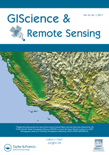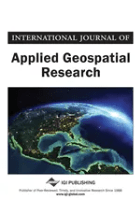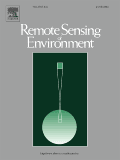
GIScience & Remote Sensing
metrics 2024
Transforming Data into Earthly Discoveries
Introduction
GIScience & Remote Sensing, published by Taylor & Francis Ltd, stands as a leading journal in the realm of Earth and Planetary Sciences, holding a prestigious Q1 ranking. Since its transition to Open Access in 2022, the journal has significantly broadened its reach, enabling researchers, professionals, and students across the globe to disseminate and access cutting-edge research related to geographic information science and remote sensing technologies. With a focus on publishing high-quality, peer-reviewed articles that contribute to the understanding of the Earth’s processes, environments, and interactions, this journal not only supports advancements in scientific knowledge but also fosters interdisciplinary collaboration. Based in the United Kingdom, GIScience & Remote Sensing continues to pave the way for innovative methodologies and applications, solidifying its vital role within the scientific community.
Metrics 2024
 1.76
1.76 6.00
6.00 7.30
7.30 63
63Metrics History
Rank 2024
IF (Web Of Science)
JCI (Web Of Science)
Quartile History
Similar Journals

International Journal of Applied Geospatial Research
Navigating the future of geography and Earth sciences.International Journal of Applied Geospatial Research is an esteemed publication dedicated to advancing the field of geospatial research. Published by IGI Global, this journal provides a platform for innovative studies from 2010 to 2024 that encourage multidisciplinary contributions across Earth and planetary sciences and geography. While currently not offering open access, the journal's focus on applied research ensures that it remains highly relevant to both academics and industry professionals alike. With an ISSN of 1947-9654 and an E-ISSN of 1947-9662, it has been indexed in various databases, reflecting its emerging significance with rankings such as Q4 in Earth and Planetary Sciences and Geography according to Scopus, placing it at the intersection of critical research and practical application. Researchers, professionals, and students can expect insightful articles that enhance understanding and drive innovation in geospatial applications essential for informed decision-making in a rapidly changing world.

International Journal of Applied Earth Observation and Geoinformation
Integrating Knowledge for a Resilient Planet.International Journal of Applied Earth Observation and Geoinformation is a premier peer-reviewed journal published by Elsevier, focusing on the integration and application of earth observation and geoinformation technologies across diverse fields. With an open access model established in 2020, this journal enhances accessibility and dissemination of research crucial for addressing global challenges related to climate change, resource management, and sustainable development. The journal occupies a notable position within the academic community, featuring a Q1 ranking in multiple categories including Computers in Earth Sciences, Earth-Surface Processes, and Global and Planetary Change, reflecting its significant impact and relevance in these disciplines. It is recognized for its high-quality articles that explore innovative methodologies and applications, making it an essential resource for researchers, practitioners, and students alike who seek to advance their understanding of earth dynamics and geospatial technology. The journal is indexed in Scopus with impressive rankings that underscore its high citation impact and scholarly influence, with an emphasis on providing a platform for the latest findings in management, monitoring, and policy in environmental science.

Remote Sensing
Advancing Knowledge in Earth and Planetary SciencesRemote Sensing is a highly esteemed journal published by MDPI, dedicated to the domain of Earth and Planetary Sciences. With an impressive impact factor reflected in its rank of #16 out of 195 in the general Earth and Planetary Sciences category, this journal achieves a commendable 92nd percentile among its peers, indicating its significant contribution to the field. Since its inception in 2009 as an Open Access journal, it has enabled researchers, professionals, and students from around the globe to access high-quality, peer-reviewed articles that delve into the latest advancements in remote sensing technologies, methodologies, and applications. Based in Switzerland, Remote Sensing serves as a vital platform for disseminating innovative research that supports and enhances our understanding of Earth's processes and environments, ensuring scientific knowledge remains freely accessible and impactful.

Revue Internationale de Geomatique
Transforming Spatial Data into Actionable KnowledgeRevue Internationale de Geomatique (ISSN: 1260-5875, E-ISSN: 2116-7060) is a prestigious journal published by TECH SCIENCE PRESS, dedicated to advancing the field of geomatics. This journal serves as a vital platform for disseminating significant research findings, cutting-edge methodologies, and innovative applications within the realm of spatial data and technology. With an emphasis on interdisciplinary studies, it fosters collaboration among researchers, professionals, and students across various domains, including environmental science, urban planning, and geographic information systems (GIS). Although not an open-access journal, Revue Internationale de Geomatique maintains a rigorous peer-review process ensuring the publication of high-quality articles that contribute to the evolving landscape of geomatics. Given its relevance and commitment to scholarly excellence, this journal is a crucial resource for advancing knowledge and practices in the ever-growing field of spatial information science.

IEEE Journal of Selected Topics in Applied Earth Observations and Remote Sensing
Transforming Environmental Challenges into Research Opportunities.IEEE Journal of Selected Topics in Applied Earth Observations and Remote Sensing is a premier peer-reviewed journal published by the IEEE-INST ELECTRICAL ELECTRONICS ENGINEERS INC, focused on advancing the field of Earth observation and remote sensing technologies. With an impressive impact factor, this journal ranks in the top quartile (Q1) for both Atmospheric Science and Computers in Earth Sciences, underscoring its significance and influence in the academic community. Open access since 2020, it facilitates broader dissemination of research findings to enhance global visibility and accessibility for researchers, professionals, and students alike. Spanning the years from 2008 to 2024, the journal covers a myriad of topics that highlight innovative applications of remote sensing data and technologies in addressing environmental challenges. With a Scopus ranking placing it in the 91st and 89th percentiles, respectively, in its categories, the journal serves as a vital resource for advancing scholarly discourse and collaboration in Earth sciences.

Geo-Spatial Information Science
Connecting Researchers and Practitioners through Geospatial InsightsGeo-Spatial Information Science, published by TAYLOR & FRANCIS LTD, is a premier open-access journal that has been at the forefront of disseminating cutting-edge research since its inception in 1998. With an ISSN of 1009-5020 and an E-ISSN of 1993-5153, this journal plays a pivotal role in the fields of Computers in Earth Sciences and Geography, Planning and Development, achieving a prestigious Q1 ranking in both categories as of 2023. Its exemplary Scopus rankings highlight its relevance within the social sciences and earth sciences, placing it among the top echelons of its field, with a 95th and 93rd percentile respectively. The journal aims to bridge the gap between innovative geospatial technologies and their applications in real-world scenarios, fostering interdisciplinary collaboration and advancing the global understanding of spatial data analysis. Based in the United Kingdom, Geo-Spatial Information Science invites researchers, professionals, and students to contribute and access research that shapes the future of geo-spatial sciences, all while adhering to open access principles that ensure broad dissemination and engagement with the broader academic community.

REMOTE SENSING OF ENVIRONMENT
Pioneering Research in Earth Observation Technologies.REMOTE SENSING OF ENVIRONMENT, published by Elsevier Science Inc, is a premier academic journal specializing in the interdisciplinary field of earth observation and remote sensing technologies. With an impressive impact factor and classified in the Q1 category for Computer Science in Earth Sciences, Geology, and Soil Science as of 2023, this journal serves as a vital resource for researchers, professionals, and students alike. The journal, which has been disseminating high-quality research since its inception in 1969, provides a platform for the exploration of innovative methodologies and applications in the assessment of environmental changes and resource management through advanced imaging techniques. While not an open-access journal, REMOTE SENSING OF ENVIRONMENT offers access options that make cutting-edge research accessible to its audience. Its strategic focus on critical issues pertaining to environmental monitoring and sustainable practices underscores its role in enhancing our understanding of the planet’s dynamics.

ISPRS International Journal of Geo-Information
Empowering knowledge through open access geospatial research.ISPRS International Journal of Geo-Information, published by MDPI, stands at the forefront of the field of geospatial sciences, contributing valuable knowledge and research insights since its inception in 2012. This open access journal, which boasts an impressive collection of articles that emphasize the integration of geographic information systems (GIS) in Earth and planetary sciences, currently achieves a remarkable standing, with a 2023 impact factor ranking in the Q1 category for both Earth and Planetary Sciences and Geography, Planning and Development. Researchers and professionals engaged in the study of spatial data, remote sensing, and innovative geoinformation technologies will find the journal an essential resource, offering diverse perspectives and methodologies. With its open access model, the journal aims to promote the dissemination of knowledge globally, fostering collaboration among scholars while pushing the boundaries of research in geoinformation disciplines. The journal is based in Switzerland and is well-positioned to contribute significantly to the understanding and application of geospatial data for societal advancements.

GEOINFORMATICA
Advancing the Frontiers of GeoinformaticsGEOINFORMATICA is a leading journal in the field of geoinformatics, widely recognized for its contributions to both Geography, Planning and Development as well as Information Systems. Published by Springer, this journal holds a distinguished Q1 ranking in Geography and a Q2 ranking in Information Systems as of 2023, reflecting its high-impact research contributions and authoritative voice in these disciplines. Since its inception in 1997, GEOINFORMATICA has provided a platform for innovative research, methodologies, and applications related to geographic information science, spatial data analysis, and remote sensing technologies. The journal's rigorous peer-review process and strategic positioning within the academic landscape allow it to attract a diverse array of publications, assisting researchers, professionals, and students in understanding complex spatial phenomena. While the journal does not offer Open Access, it remains a vital resource located in the Netherlands, and its indexed status has secured impressive Scopus rankings—#131 in Geography, Planning and Development, and #134 in Information Systems, showcasing its robust scholarly influence. Explore the latest developments and cutting-edge research through GEOINFORMATICA, where scholarly excellence converges with real-world relevance.

Journal of Geography-Chigaku Zasshi
Advancing Geographical Insights for a Changing WorldJournal of Geography - Chigaku Zasshi is a distinguished publication that serves as a crucial platform for the dissemination of research in the realm of geography and earth sciences. Published by the TOKYO GEOGRAPHICAL SOC in Japan, this journal is indexed with an ISSN of 0022-135X and an E-ISSN of 1884-0884. With a scope that includes Earth-Surface Processes, Geography, Planning and Development, Geology, Geophysics, and Global and Planetary Change, it provides comprehensive coverage of pressing geographical issues. Although it holds a Q4 ranking in multiple categories as of 2023, the journal presents an opportunity for researchers, professionals, and students to contribute meaningful findings in a diverse and competitive landscape. The Journal of Geography actively promotes scholarly dialogue by embracing the complexities of our planet and encouraging innovative approaches to geographical inquiries. This open-access journal aspires to bridge gaps and foster collaboration among scholars worldwide, underscoring its importance in understanding and addressing contemporary geographic challenges.